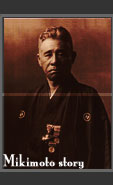| |
"Pearl", is highly valuable, with a long and historical presence,
known in the past as "the Queen of Gems". As such, only persons
of high social status, or members of royal families were able to wear
them. Pearls are treasured throughout the markets of Asia, America and
Europe, especially in Asia, where they are woven together intrinsically
with ancient beliefs. The Egyptians believed that drinking wine with pearls
dissolved in it would help retain their youth. There is also evidence
that Queen Cleopatra drank this concoction believing it would maintain
her famed beauty.
A record in the historic book 'Myths of China and Japan' mentions that
dragons were a pearl-eating species and goes on to narrate how dragons
had in their mouths and throats, pearls worth a hundred gold ingots. When
they fought in the sky, dislodged pearls would often fall back to earth!
Chinese and Japanese therefore believe that pearls are more valuable than
gold and treasure them for worship purposes, or religious ceremonies.
|
|
| |
Homer, the Greek Master Poet in the period 1200-850
BC described in a verse that "a Roman angel called Euno wore
pearl earrings". It can be surmised therefore that pearls have
been used as ornaments since before the time of Christ.
In
Thailand pearls do not appear to have enjoyed an image as a popular
ornament, as they are very rarely mentioned in old archives. Nevertheless,
they were mentioned in "Tamranopparat" composed during
the reign of King Rama II (the original manuscript used the term
"pearl" and "pearl egg"). In short, pearl has
had many associations, often with various animals or other elements
of nature. Ancient Thais tended to associate pearl ornaments with
various tales of supernatural powers.
|
|
|
Pearls also feature prominently in ancient
times in many countries; certain periods can be identified in some
cases, while others cannot. Some writings state that the Chinese
used pearls for the first time over 2,500 years ago. Some say the
oldest pearls known today were found in Persian graves, some 400
years BC. Ornaments from natural pearls during the early periods
were often found in countries around the Persian Gulf and Sri Lanka.
"Pearls" are organic matter,
or living creatures, and are characterized into two major groups:
natural pearls and cultured pearls.
1. Natural pearls come from pearl shells.
They arise from the embedding of small living creatures in the body
of the pearl shells, which cause irritations. Sand particles may
also enter the body of the pearl shell and cause irritations which
stimulate secretions forming pearl layers, known as Nacre, that
cover the small living creatures, or sand particles, and eventually
become a pearl. |
|
|
2. Cultured pearls are man-made pearls formed by embedding
foreign matter into the body of pearl shells - a technique
first used by the Chinese. Since the 13th century when pearls
became scarce as their popularity increased, various other
processes have been used to produce cultured pearls to replace
natural pearls. The Japanese were the first to succeed with
one of these techniques and were the first to call them cultured
pearls. They began producing them in ever increasing numbers
during the 19th century, until the technology was later developed
and propagated around the world. Thus there are now many cultured
pearl farms in Australia, Indonesia, Burma, Thailand, French
Polynesia and China.
3.
There are two types of cultured pearls:
3.1
Saltwater cultured pearls are raised by implanting round beads
made from freshwater shells with small mantle tissues into
the ovaries of mothers of pearl. The shells then secrete pearl
layers to plate the beads. Many seawater mothers of pearl
types are employed. Saltwater cultured pearls are rather more
rounded in shape due to the implanted round beads.
3.2 Freshwater cultured pearls, use only mantle tissues from
other freshwater shells for implantation. Freshwater cultured
pearls are therefore of irregular shape when compared to the
rounded characteristics of saltwater cultured pearls. China
is now the principal producer of freshwater cultured pearls.
|
In the past, freshwater cultured pearls could easily be distinguished
from the saltwater variety by their size and shape. As there
is no implantation of beads in freshwater cultured pearls,
they tend to be smaller in size and irregular in shape. However,
with advancements in development, freshwater cultured pearls
are now also rather more rounded and about the same size as
the saltwater variety.
The
two types of pearl can be distinguished by observing them
closely through a magnifying glass. Through a drilled hole,
pearl layers and beads can be found in saltwater cultured
pearls, but not in freshwater cultured pearls. If drilling
is not possible, or the pearl is in a setting, then tests
by an expert, using high-tech testing instruments, is necessary.
The instruments include EDXRF (Energy Dispersive X-Ray Fluorescence)
and X-Radiography. The EXERF will detect manganese found only
in freshwater cultured pearls, while the X-Radiography will
test the internal structure of saltwater cultured pearls,
which should show clearly the beads and the layers of pearl,
characteristics not found in freshwater varieties, but mantle
tissues will be found instead.
The
technology of raising freshwater cultured pearls has advanced
greatly in the present day.The process of producing round
pearls without implanting a nucleus, has now been superseded
by a drive to make them bigger after a rounder nucleus has
been implanted. In the future freshwater cultured pearls will
adulterate saltwater cultured pearls. Buyers will therefore
have to be more careful in their identification in the future.
|
|
Pearl analysis for beginners with GIT
We have all made an acquaintance with the gem known
as "pearl" to varying degrees and now The
Gem and Jewelry Institute of
Thailand (Public Institute) [GIT] is pleased to provide
you with a simple guideline to enable you to recognize
and select pearl yourself with confidence.
The few criteria in pearl selection briefly include:
1. A good pearl must have a high and regular luster.
An easy test, is to look at it through a light, either
a torchlight, or neon light. Turn the pearl around
to ensure the luster is evenly distributed over the
whole pearl.
2. The orient (iridescent luster) of a pearl will
be perfectly distributed over its entire surface only
if the pearl layers are thick. If it shows much color
overlapping through a light beam, it is usually a
good thickly layered pearl. This thickness depends
on the raising period and the pearl's environment.
A thickly layered pearl will be more orient than one
which has grown too fast, producing an uneven layer
thickness and displaying less orient.
3. Here are some easy ways to check
the thickness. Observe:
|
•
the luster: the higher the luster - the thicker
the layers
•
any cracks on the surface. If the layers are
thin, the centre plastic ball can be clearly
seen
•
the drilled hole through a magnifying glass,
if the layers are not thick, the connecting
areas between the pearl and the centre ball
can be clearly seen
•
the color strips through a high-density light,
such as a red colored light, if the cross strip
of the centre ball can be observed, the pearl
layers are very thin.
4.
Color of the pearl. Two colors are popular in
the market: first, Body Color, mostly white,
creamy, yellow, etc. Second, Overtone, mostly
green, pink, silver or sky blue. Prices of pearl
depend more on fashion than anything else. This
year, Tahiti pearls, or black pearls with a
shade of gray, or green, command the highest
price at 25,000 baht (diameter 13 mm.) per pearl.
5.
The Surface of a pearl is an important criterion
that quickly reveals the pearl's quality. If
the pearl surface is not smooth, or is cracked
or blemished in some way, or the layers are
thin, then the layers may peel away easily and
rapidly. To select a good pearl therefore, its
surface must be smooth and shiny, with no cracks
or scratches. Rolling it under a light with
a black background will reveal its surface condition
very clearly for your observation.
|
|
|
The most important facet in
pearl selection is being able to distinguish
natural pearls from imitation pearls, which
can be made from glass, plastic, or other materials.
Imitation pearls can be easily identified when
checking for cracks or surface scratches, as
they are normally coated with lacquer, or other
coating substances, producing poor luster and
orient. Or if you rub them together lightly,
you will notice their coarseness. Make sure
you rub them very lightly, otherwise you will
damage their surface. If while rubbing you do
not detect any coarseness, but it feels very
smooth, it can generally be surmised that they
are not genuine. Importantly, it is not advisable
to use the traditional test of rubbing a pearl
on your teeth, as this might destroy the peaffs
fragile surface. Colored pearls are mostly black
to imitate expensive black pearls. They are
colored by using either silver nitrate or radiation,
which cannot be discerned by normal sight. |
|
|
If you want to
know, for sure, whether your purchased
pearls are genuine, or not, you can have
them tested using the latest high tech
test equipment in the laboratory of the
Gem and Jewelry Institute. The test equipment
can quickly differentiate between genuine
and non-genuine pearls, revealing also,
whether they are fresh water, or salt
water cultured pearls, or natural pearls.
The equipment uses the latest scientific
analysis techniques to test the pearls
thoroughly without any detrimental effect
on the pearls being tested. In addition,
the test equipment will also reveal the
age of cultured pearls by their layer
thickness, which is the current criterion
used in pricing a pearl.
It is further
advisable to exercise special care when
purchasing black pearls. The Gem and Jewelry
Institute provides a whole range of expert
tests, which extend to tests on every
type of gem, while providing assay analysis
and certifications of purity of precious
metals. |
| |
|
|
|
|
|
|
|
|
|





















